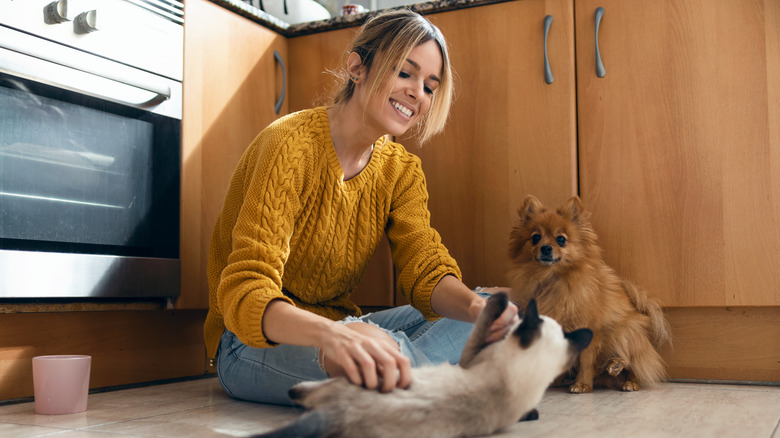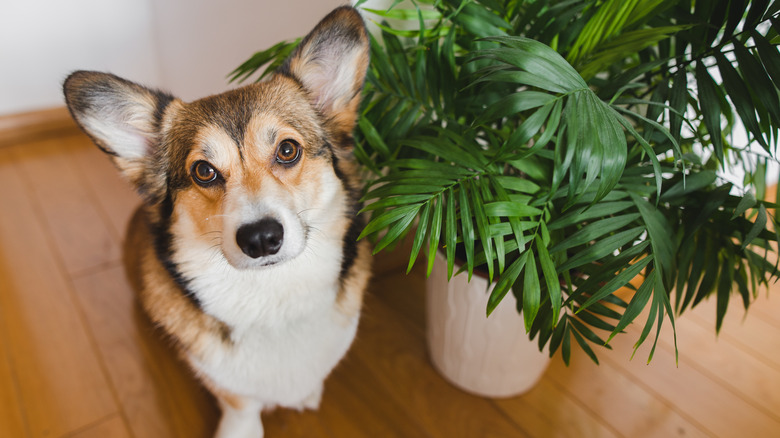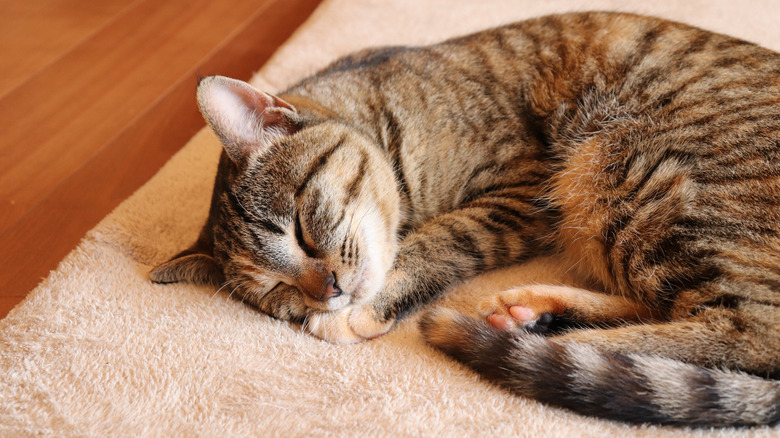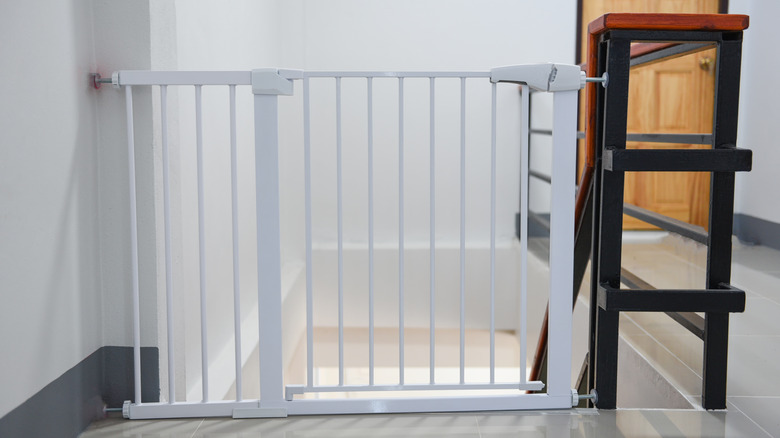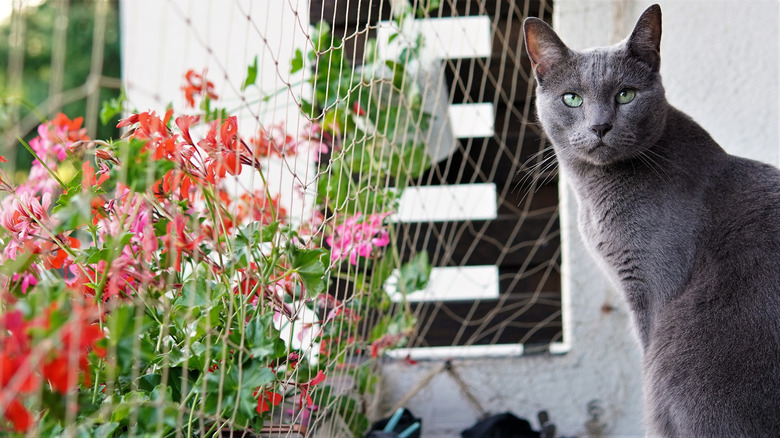The 5 Best Ways To Get Your Home Ready For A New Pet
Do you own a cat or a dog? Thinking about adding a furry friend to the family? Then you're certainly not alone. In fact, most U.S. households have at least one pet, according to the CDC. More specifically, dogs can be found in a whopping 69 million residences, while 45.3 million American abodes include cats, per Pet Keen. That's not to mention the houses, apartments, and condos that are the domiciles of fish, birds, rodents, and reptiles.
But when it comes to keeping a home stylish (and functional) with a beloved companion in tow, consider how your living situation might (or might not) work for each animal. For instance, if the critter will grow to be rather large, ensure there's enough space handy. Additionally, keep in mind how much movement and exercise it will require, as well as how and where you plan to bathe it. Don't forget to also jot down any creature comforts or special accommodations.
Of course, along with those key aspects to keep in mind, be well aware of what's needed to get your home ready for a new pet, including the following important tips.
1. Address potential dangers
Along with wanting your home to be a happy place for a new pet, be sure it's also free from any harmful elements. As such, depending on the type of animal you're getting, you'll want to address different and specific issues. However, there are definitely a few things all owners should watch out for.
Getting a new cat or dog (or something else entirely) that might end up nibbling on things it comes across? Then make sure any houseplants are safe for your pets. Remove anything that's poisonous, such as lilies, tulips, oleander, and begonia, according to WebMD. Additionally, get rid of any sago palms, Schefflera, and amaryllis, while keeping both holly and mistletoe away during the holidays.
Beyond that, ensure any cords and wires aren't an issue. Sadly, canines or felines can be electrocuted when they chew on cords, per PetMD. That's why Fitbark suggests tucking away cords where pets can't get to them or running wires above walls and doors so that they're out of reach. Finally, be just as mindful when it comes to hiding chargers, power bars, adapters, and anything else that could give off a nasty shock.
2. Make your floors pet-friendly
With a cat or dog now constantly scurrying about, it's vital to have a pet-friendly home. This means ensuring that surfaces can stand up to scratches and won't be too slippery for small paws. On top of that, it should be easy to clean in case your animal sheds a fair share or tends to piddle here and there before they're properly trained. Then again, you may need to set up something new altogether. Rigid core flooring and engineered tile are both good options, according to Armstrong Flooring. Otherwise, vinyl sheets and tiles could very well do the trick.
Of course, not everyone will be willing or able to install new coverings if necessary, even if their current flooring won't hold up against pets. In that case, you can put down a rug, according to Scary Mommy. A handy and stylish way to keep animals from slipping, scratching up, or staining wood planks or tiles that are safely hidden beneath, there's also the option of picking out an animal-friendly rug that's purposefully been made to resist the various issues your furry family member might present.
3. Get an indoor gate
It's no secret baby gates are meant to protect little ones from wandering about or getting too close to the stairs. With that same sort of goal in mind, consider purchasing an indoor gate to make sure any pets remain in secure areas and away from places they shouldn't be getting into.
For instance, if you have a new dog, then erect a doorway or hallway gate to prevent them from running outside when someone opens the front or back door, according to K9 of Mine. Moreover, close off access to potentially dangerous rooms, like the kitchen and laundry room.
Although keeping pets out of potential problematic rooms or spaces might make you feel bad at first, K9 of Mine notes that it results in greater comfort and security. By putting up gates and indicating which areas are off limits, it will give them a chance to learn various dos and don'ts, even when the fencing is down. Once they understand what spots in the house or apartment are okay, they'll feel more assured about their place in your home.
4. Set up their special spots inside
When a new pet is first welcomed home, they tend to settle in much easier — and faster — with a dedicated space or two indoors. As such, in addition to a comfortable plush bed, consider setting up both an exercise pen and a crate somewhere for your dog, according to Rover.
On the other hand, if you adopted a new cat or kitten, then you'll not only want to assemble a crate and bed, but also reserve an area for their food and water bowls, as well as a litter box before they arrive.
As for any aquatic animals, set up a bowl or tank featuring some lighting, plants, and stones or sand to create a cozy underwater environment. Granted, initially, it's all about finding a perfect spot in the house. More specifically, All Pond Solutions points out it's best to position such containers away from abundant sunlight to prevent algae from growing inside too quickly. Additionally, make sure it's somewhere that won't be hard to access in order to feed your fish and keep their home in tip-top shape.
5. Pet-proof any outdoor space
Along with prepping the interior of your home, check out any outdoor spaces to see if they're suitable for your canine or feline companion. For instance, if you have a yard and will be welcoming a new dog, clean up everything, address any overt smells, and get rid of potentially hazardous or poisonous plants, according to Rover. Additionally, pick out spots where they can play, rest, and do their business.
For a cat, add overhead netting to prevent it from escaping. If that doesn't work, then a catio might be the best option. When it comes to making a balcony an area where pets can spend some downtime, dog owners should consider putting up nets, panels, or fencing to secure the space, per Balcony Boss. Don't forget to also keep your outdoor furniture and barbecue in spots that won't pose any danger. The same basic setup will work for your cat, although you'll want to adjust things slightly to suit them.
Getting another kind of animal? Then adapt your backyard for their particular needs, ensuring they remain safe and happy in their new home.
